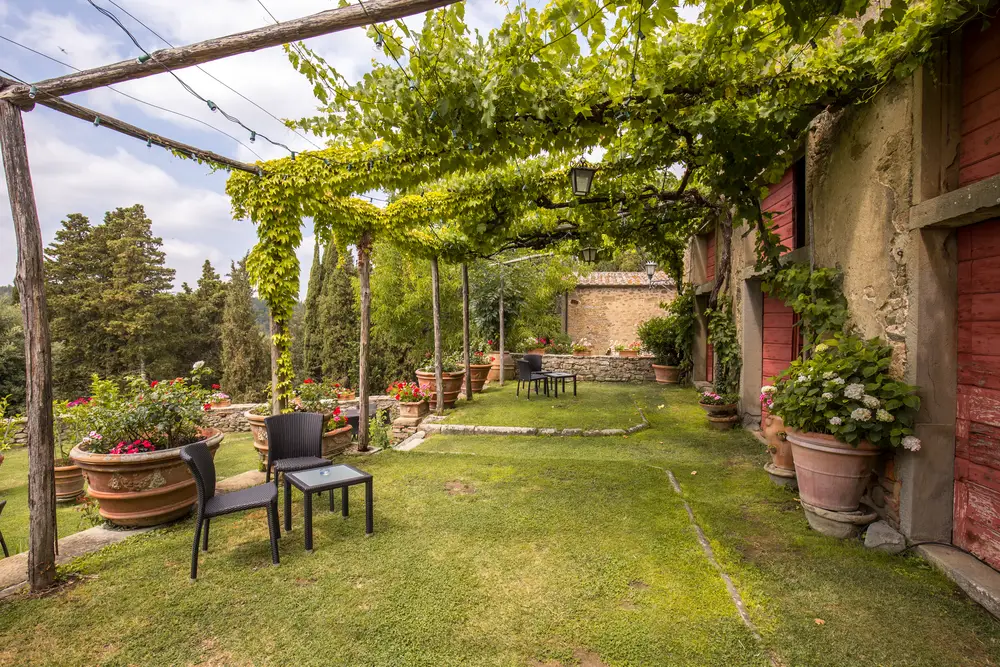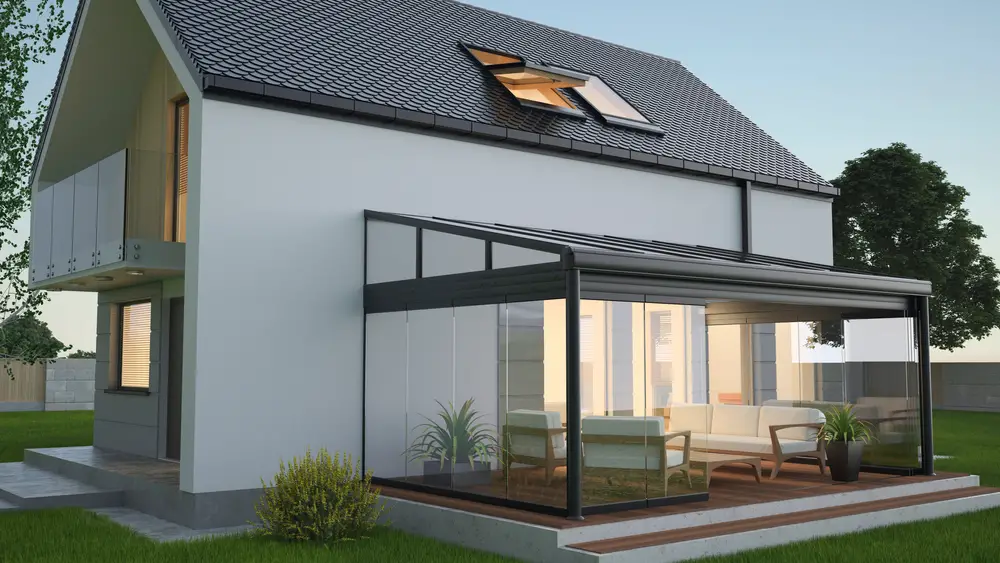A patio contributes much more to your home than just additional living space. It is excellent for relaxation, entertaining friends, enjoying garden views, and escaping from the indoors. Being able to use it whenever you feel like it, irrespective of the weather, is not just wishful thinking but an achievable goal and one that is not too difficult to achieve.
There are a lot of different options for shielding your patio from the rain, choosing one will depend on your preferred style, how often the patio is used, how frequently and heavily rain falls in your area, and budget restraints. Possibilities to consider include:
- Awnings
- louvered roofs
- Fixed roofs
- Natural cover
- Retractable wall blinds
- Fold-away walls
- Shower curtains
The first step in protecting your patio from rain is to work out how much you really want to spend on it. Once you’ve decided on your budget, the decision-making revolves around the type of covering, the design, materials and whether to contract the project out or do it yourself. It is a wonderful way to increase the value of your home and improve your quality of life at the same time if you do it right!
Consider Basic Facts About The Rain In Your Area
Before deciding on what type of patio protection is best, you need to consider a few variables below.
What Is The Prevailing Wind In Your Area?
In most areas, rain is seasonal, either in the Summer and the Spring as in most of the US or in the Winter as in the West Coast. The prevailing rain-bearing winds will dictate which side of your patio needs the most protection and which could be left open. For example, in my home state of North Carolina, the prevailing winds are typically from the southwest for most of the year and from the Northeast during September and October.
Rain does not typically fall exactly straight down, but at an angle. This is due to fluctuations in the wind. You might notice that in areas like the coastline, residents frequently have to deal with “driving rain” because of the frequency of heavy winds.
How does wind impact your strategy for blocking rain? Well, depending on where your patio is located in proximity to your home, you may notice that certain areas of your patio never get wet whereas others get drenched during storms. If you already have some natural coverage such as trees, you can consider whether that is enough protection to prevent rain from certain sections of your patio.
How Much Rain (And Snow) Falls
If you get light rain more often than downpours, you can choose a less substantial roof cover than if you must protect your patio from heavy rain and the possible weight of snow in the winter.
Annual precipitation varies significantly by region, if I lived in a relatively arid environment like most of Oklahoma or many parts of Arizona, I would strongly consider using the shower curtain method to protect my patio space during the few rainy months out of the year. On the otherhand, North Carolina gets a lot of rain during a large portion of the year so a roof is a better option.
How To Block Rain With Different Types of Roof Cover
Several patio coverings will provide protection, and they can be fixed, retractable, or even naturally grown. Whichever you decide looks best, and works best for you, in your home and your area, is entirely your own decision.
Using Natural Foliage To Block Rain

Create a leafy, green canopy by erecting a pergola and planting creepers at the base of the uprights, which will grow up and over onto your slatted roof to give you protection from rain and sun.
You will need to be patient as it will take a while before it is truly effective, and it’s never going to be one hundred percent waterproof, but it is an aesthetically pleasing option.
There are lots of different plant options to consider if you decide to go with natural foilage. You will generally want to lean toward a fast-growing variety, that way your time waiting for rain protection will be shortened. Popular options for green roofs include: Wisteria, honeysuckle and grapevines. Grapevines of course have the advantage of also providing some delicious fruit after several years of growth.
The biggest disadvantage of a green canopy is of course the time that you will have to wait for it to be effective. If everything is done correctly you will likely need to wait around three years until you see significant rain protection.
A Fabric Awning Is A Cost-Effective Option To Block Rain
There are many different awning designs you can consider, using a variety of materials to cover your patio:
- Fixed fabric awnings stretched over a metal, wooden, or composite framework. Typical fabrics are canvas and shade cloth, which are available in a wide range of solid colors, stripes and quality but are durable and cost-effective.
- Retractable awnings are made of the same material but secured to a supporting frame or pergola with a rope-and-pulley system which allows the awning to be pulled out over the patio or pulled back, depending on the weather. This movement can be controlled electronically with a remote or manually if your budget is limited. Quality retractable awnings can be purchased for as little as $250.
- Swing-arm awnings are great for smaller patios as they require no pergola support but are mounted to the back wall and extend over the patio on strong load-bearing hinged arms.
Using Rigid Roof Materials To Block Rain
Depending on your local climate, you might want a more substantial, more rain and wind-resistant covering than canvas over your patio. Depending on what materials and design you decide on, fixed roofs may need a more robust support structure, such as brick pillars and heavy-duty beams, to carry their weight.
- Solid roof sheeting over a supporting framework will offer total protection but may cut out a lot of light from your interior. You can solve this problem by using transparent polycarbonate sheets on their own or combine with solid sheeting. Just remember to ensure that you avoid leaks by using the same profile for both.
- Retractable glass roof covering is a great option but also the most expensive. A series of glass panels that slide backward and forwards using an electric motor or by hand provides all the protection you need without detracting from the quality of light in the patio.
- Adjustable louver roofs are also operated manually or by an electric motor. The roof does not retract, but the aluminum louvers can pivot almost one hundred and eighty degrees from fully open to fully shut, allowing the sunshine in summer, and blocking the rain when it falls. It is also possible to link rain sensors to the motor to close the roof automatically when it rains.
Protecting Your Patio Requires More Than A Roof

While any of the above options will do a good job protecting your patio from the rain, it won’t save your patio from the forces of driving rain. If the rain is accompanied by high winds or even a gentle breeze, it is not going to fall vertically onto your patio. You will need to block it at least from blowing in on the windward side, and unless the patio is facing directly into the wind, that will mean blocking at least two sides of your patio. To make things really cozy in winter, you may want to close all three sides, assuming the fourth side is the connection with the house.
- Greenery and densely leafed shrubs are the softest and most natural way to block rain, but, as with the roof, they are never 100% effective or the quickest method.
- Vinyl curtains are cost-effective and are worth considering unless the rain is accompanied by a strong wind. If that does happen, the lighter fabrics may not be the best solution, as they will simply be blown out of position and let the rain through. Curtains made from heavier gauge vinyl and hung from rods in the usual manner can also be weighed down at the bottom so that they can withstand intense winds.
- Roll-down canvas or vinyl blinds are a popular choice for homeowners with a limited budget. They can be solid or have transparent plastic windows sewn into them to allow light into your roofed patio. The individual blinds can be zipped or fastened together to form a solid wall.
- Sliding Wall Panels that run on a track around the perimeter of your patio are not a cheap option but a very elegant one. They can be installed so that they can enclose the patio completely or be moved independently to protect specific areas from rain.
- Bi-Fold permanent glass panels, which can be frameless but are typically aluminum- or wood-framed and hinged to fold back to allow flow to the garden, are a really practical and durable option to consider.
Conclusion
Patios have a definite place in any home, as they provide the transition between the enclosed interior of the house and the open space of the garden. When the weather’s perfect, they are the place where we gravitate, either to relax peacefully and read a good book or entertain friends.
You certainly want to avoid turning the patio into another room in the interior of your house, but there are ways to protect it from harsh weather and to block rain from the patio. If you do this well, you not only allow yourself the chance to enjoy that space for many more days in the year, but you add significantly to the value of your most important asset, your home.
References
https://www.mysmartserve.com/patio-rain-protection-ideas

